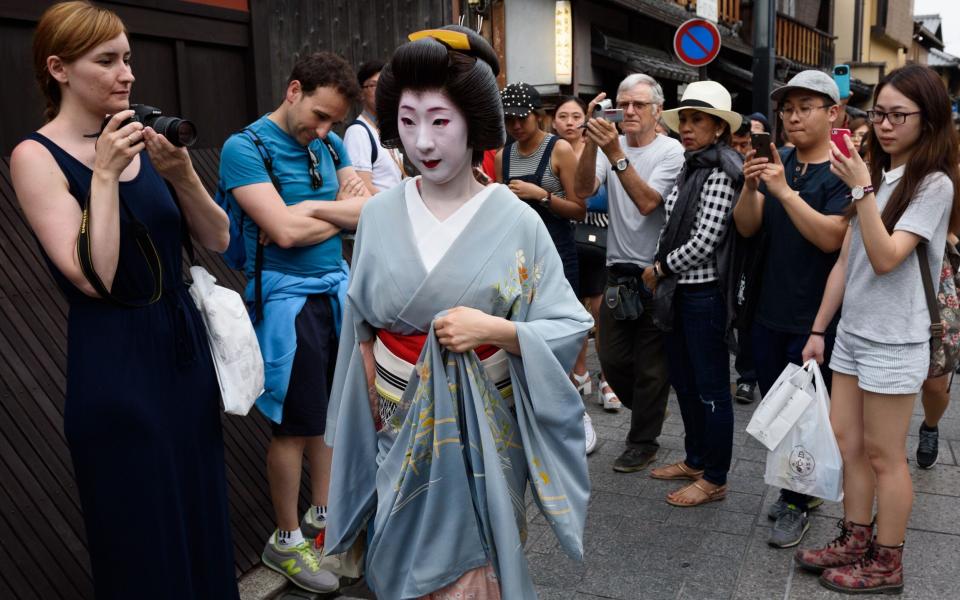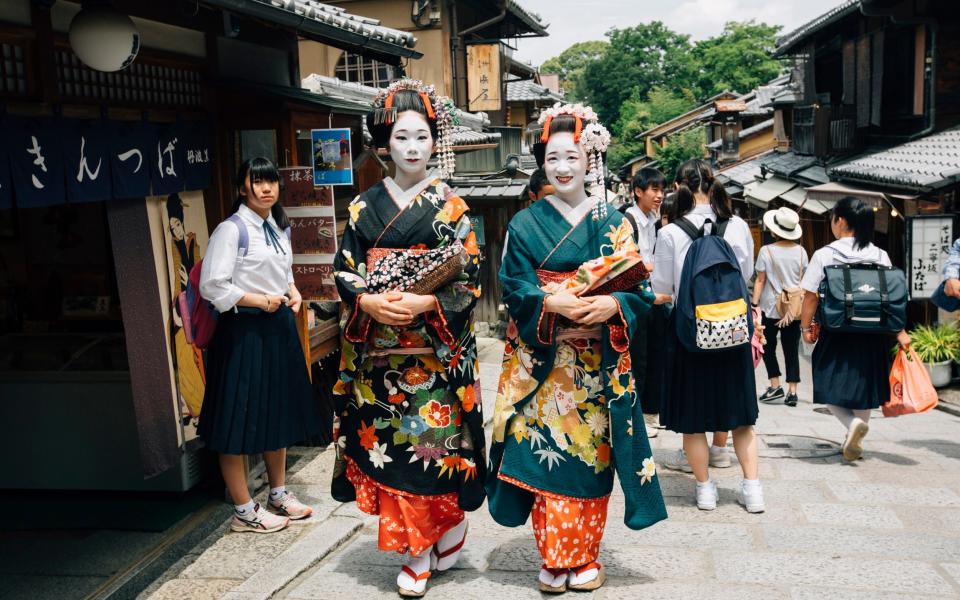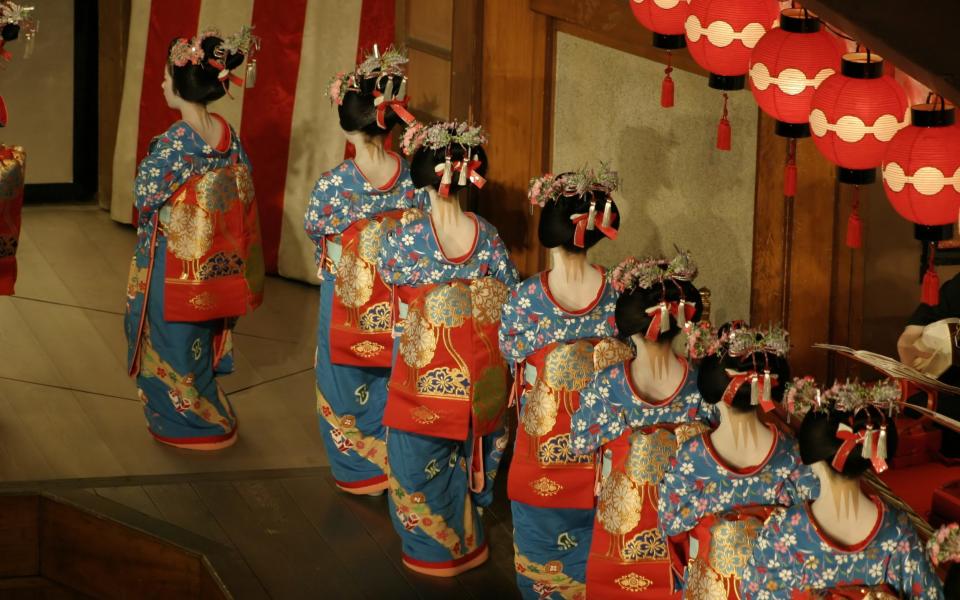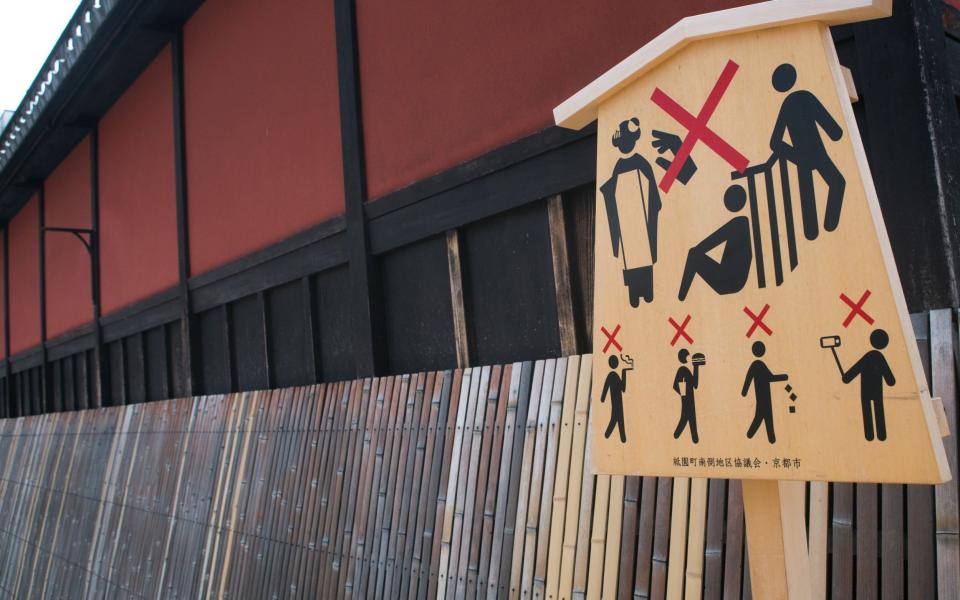A tuft of silk kimono. Clip of wooden shoes on cobblestones. Red lips shine on a white painted face.
For many visitors to Kyoto, capturing the dreamy image of a geisha is like a holy grail. Filled with rituals and full of beauty, a geisha is one of the most poetic expressions of Japan’s traditional cultural heritage.
But as enticing as Kyoto’s so-called world of flowers and willows is, especially for tourists, it has long been hard to blink and miss, and it will soon become harder than ever to witness it.
This week, authorities in Gion, Kyoto’s historic geisha district, announced plans to restrict access to a centuries-old network of atmospheric backstreets lined with time capsule teahouses and wooden residences in a bid to stem a sharp post-pandemic surge in tourism.
The move follows a series of complaints, ranging from tourists chasing geishas through the streets to take photos, to one’s kimono being torn and another’s cigarette stubbed out on her collar.
While some of these incidents are extreme, the overcrowding of Gion’s scenic backstreets is a growing problem that is deeply at odds with the rarefied and exclusive culture that has long defined the essence of the geisha world.


Many experts see overtourism as only part of the problem, blaming it on tourists’ general lack of awareness of the delicately nuanced layers of Japanese culture.
As expert Japan tour operator James Mundy of InsideJapan Tours (insidejapantours.com) explains: “Kyoto is a beautiful place and popular for good reason. And to some extent, it’s understandable that crowds of tourists flock there trying to get the perfect picture of a temple or a photo of a geisha. But this is about responsible tourism and cultural awareness, which some large tour companies and individuals are not interested in. Instead, they focus on getting that photo for their social media.
“Popular temples and shrines are part of daily life for locals, and some of the more popular sites are hindered by tourist crowds. “It is the disruption to daily life and, more importantly, the lack of cultural respect and awareness that has angered some locals and led local authorities to take action.”
What is Geisha?
There is often a blurred understanding of what it means to be a geisha.
The centuries-old world of geishas (or geiko, as they are called in Kyoto) is a long-standing symbol of sophistication, beauty, and mastery of traditional arts.


Rigorously trained for years as apprentices (known as maiko), they are highly accomplished entertainers who have mastered a blend of traditional Japanese art forms, from dancing to playing musical instruments, from the tea ceremony to the art of conversation.
The Geisha world has existed for a long time, especially in Kyoto. The ancient city was the capital of Japan for more than 1,000 years until the late 19th century.This century and was thus the birthplace of countless iconic traditions. Like tea ceremonies, ikebana flower arranging, and kimono fabrics, the world of geisha is deeply engraved in the fabric of Kyoto’s cultural DNA and local life.
As Mundy explains: “There are many misconceptions about geisha. The first is that they are prostitutes, which they are not. Geishas have long careers in the performing arts, allowing them to provide a specialized traditional entertainment service that includes dance, music, drinking, games and conversation.” “They are respected traditional hostesses with years of training. They are definitely not tourist attractions, but rather guardians of a traditional culture.”
Where can you experience authentic geisha culture today?
While Gion is the most famous center for geishas in Kyoto, it’s not the only place where tourists can get a taste of this world of willows and flowers.


Kyoto is home to five traditional geisha districts known as Hanamachi, meaning “flower town,” and many neighborhoods offer a more low-key, local experience.
But wandering the streets of these districts with an iPhone in hand in the hope of seeing a geisha is not the best way to do this. Not only does overtourism contribute to problems and interfere with daily life, but it also rarely reflects the beauty and essence of experiencing the skills of a geisha.
Instead, choose a reputable tour operator or luxury hotel, many of whom can provide access to an authentic experience by booking a tea ceremony or dinner at a private teahouse with a geiko.
For a more budget-conscious experience? Gion Corner also offers a traditional performing arts and cultural program with a one-hour show featuring the Kyoto dance of maikos, as well as a tea ceremony, ikebana and kyogen comedy. Visitors can even take photos with maiko or geiko here. Tickets are available online (kyoto-gioncorner.com) and through Kyoto Tourist Information Center Kyo Navi (kyoto.travel).


What rules and etiquette should you follow when meeting a geisha?
The do’s and don’ts are clear in the Kyoto City Official Travel Guide, prepared by the Kyoto City Tourism Association in conjunction with Kyoto City. For example, visitors are asked to avoid stopping, following, or taking unauthorized photos or videos of the geisha as they move around.
Additionally, a “Mind Your Manners” campaign is being promoted through posters throughout Kyoto city, giving more general advice, including:
-
Move silently when exploring residential areas or religious sites
-
Don’t follow the crowd
-
Leave your luggage behind
-
Do not take photos in prohibited places